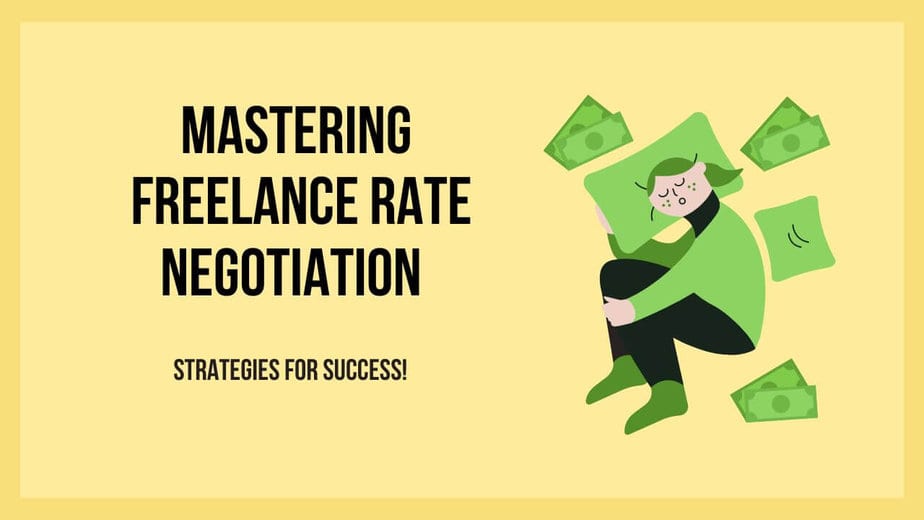Introduction
Are you a freelancer who is afraid of negotiating your rates? We have all been there. In the ever-evolving landscape of freelancing, there’s one skill that can truly set you on the path to financial sustainability and professional success: the art of negotiation. Picture this – you’re a freelancer, passionate about your craft, and determined to make your mark in the world of remote work. Yet, if you’re not a master in freelance rate negotiation, your dreams of a thriving freelance career may remain just that – dreams.
Understanding Freelance Rate Negotiation
Freelance Rate Negotiation is not just a buzzword; it’s the linchpin that can determine the trajectory of your freelancing journey. If you possess the confidence and skills to negotiate your rates effectively, you would no longer have to settle for less than you’re worth.
Just like the path to a sustainable income, it starts with understanding the art and science of negotiation.
You see, negotiation isn’t a complex or intimidating endeavor. It’s about being poised and respectful while presenting your proposal with confidence. It’s a matter of standing your ground without the need for confrontation. Negotiation is the key to opening the door to better pay and a more promising freelance future.
Now, you might be wondering why negotiation is so pivotal in freelancing. The answer lies in the limitations that this business model can impose on your earning potential. Two factors play a crucial role in determining your freelance income:
- The number of billable hours you work.
- The rate you charge.
We’re going to zero in on that second factor – the rate you charge.
We understand that the notion of negotiating rates might be met with reluctance by many freelancers. However, mastering this art is not just beneficial; it’s imperative for your freelance business’s prosperity.
Tips for Freelancers on Negotiating Rates:
1. Start with Informed Research
Knowledge is your most potent tool when negotiating rates. Before diving into any negotiation, take the time to research industry standards for the services you offer. Seek insights from experienced freelancers in your field or connect with a mentor to gauge whether your proposed rates align with industry norms. Online job listings, freelance community forums, and LinkedIn groups can also provide valuable salary data. Armed with this information, you’ll approach negotiations with confidence.
2. Ask About Their Budget First
One effective strategy for securing higher rates is to let the client initiate discussions about budget. Begin by asking the client for their project budget or a range they have in mind. This approach enables you to tailor your proposal to their financial expectations rather than relying on assumptions. Surprisingly, you might find that the client is willing to pay more than you initially thought.

3. Determine Your Minimum Acceptable Rate (MAR)
Before entering any negotiation, it’s crucial to establish your financial bottom line, known as the Minimum Acceptable Rate or MAR. Think of this as your safety net – the lowest equivalent hourly rate you’re willing to accept for your work. Calculating your MAR involves considering your personal and business expenses, along with tax obligations.
Here’s a simplified formula to help you calculate your MAR:
MAR = (Personal Expenses + Business Expenses) / Hours Worked + Tax
For instance, if your annual personal expenses amount to $60,000, your projected business expenses are $10,000, and you plan to work 6 hours a day for 48 weeks (1,440 hours total), your MAR calculation (before tax) would be:
MAR = ($60,000 + $10,000) / 1,440 = $45.83
Taking into account a 30% tax rate, your net MAR would be approximately $59.58.
While your MAR serves as your financial safeguard, it doesn’t necessarily represent the rate you’ll propose to clients. Instead, it’s a figure you won’t compromise below during negotiations, unless unique circumstances dictate otherwise.
Your MAR may evolve over time. Initially, it’s based on your desired quality of life. However, as your freelance business grows, you might adjust it to reflect the lifestyle you aspire to achieve. Let your proposed rate align with your freelancing goals, and you might be pleasantly surprised by the outcome.
4. Present Your Rates Confidently
Remember, negotiation is essentially a business conversation between two parties. To succeed, be well-prepared before entering negotiations. Clearly define your goals and have a realistic rate in mind. Be ready to explain your rationale and remain open to the client’s perspective. Confidence and an open-minded approach are key to achieving a successful outcome.
While some freelancers prefer to present their rates as a range to appear less demanding, be prepared to accept the lower end of the range if necessary. However, be mindful that the client might counter with a lower rate than you’re willing to accept, so have a courteous and professional refusal prepared.
5. Negotiate Based on Their Perception of Value
Effective negotiation isn’t solely about what you believe your services are worth; it hinges on understanding the client’s perspective and the project’s value to them. To determine an appropriate rate, ponder these questions:
- How will your work benefit the client?
- How will it positively impact their bottom line?
The answers guide your rate. For example, a blog post for a small business might have a limited impact, warranting a moderate rate. However, writing sales page copy for a Fortune 500 Company’s major online product launch could offer significant benefits, allowing you to price accordingly.
While these examples are extreme, the principle applies to every negotiation. Tailor your rate to what the project is worth to the client, ensuring a mutually beneficial outcome.
6. Start High
Negotiating rates is standard in business, and many clients may naturally try to haggle, even if they find your initial rate reasonable. To account for this, propose a rate higher than your ideal. Starting on a higher note allows room for negotiation, and even if the client negotiates you down to a rate you would have accepted anyway, both parties feel like they’ve achieved a favorable outcome.
Clients rarely outright reject a rate, unless it’s significantly out of alignment with expectations. By proposing a rate about 10% higher than your comfort level, you create a negotiating buffer, fostering a collaborative and positive client relationship.

7. Communicate Concisely
Respect the client’s time by keeping your communication concise and focused. Lengthy explanations may convey a lack of confidence and test their patience. Instead, get straight to the point while substantiating your proposal with data or examples.
Offering flexibility in your negotiation can also be advantageous. Presenting multiple options, even if they involve delivering a scaled-down scope of work, demonstrates your willingness to collaborate and find common ground, increasing the chances of a mutually agreeable agreement.
8. Showcase Value-Based Evidence
If your proposed rate exceeds industry averages, be prepared to justify the additional cost by emphasizing the value you bring to the table. Especially when dealing with larger organizations, the client may need to explain the higher expense to others. Share specific examples from your experience, such as advanced qualifications, a broad range of services, or a satisfied client portfolio that attests to your expertise.
9. Consider Non-Monetary Benefits
In cases where the client’s rate falls slightly below your expectations but not significantly, assess whether non-monetary benefits can compensate. For instance, if the project allows you to create a portfolio sample or offers exposure within your industry, it might be worthwhile to accept a slightly lower rate. While it’s important not to make this a habit, occasional non-financial perks can balance the equation.
10. Formalize Agreements in Writing
Protect your interests by documenting all agreements in writing. Request a written contract from the client outlining the scope of work, agreed-upon rate, and project deadlines. In cases where a formal contract isn’t possible, ensure you at least have an email confirmation of the agreement. This step serves as a safety net, safeguarding you in case of payment issues or scope misunderstandings.

11. Charge Per Project
Working by the hour can impose an income ceiling on your freelance career. For instance, if your hourly rate is $100, and you work six billable hours daily, your daily income caps at $600. In contrast, charging per project offers the potential for limitless earnings.
Consider this: A client offers you a blogging project, estimating that each post will take three hours to complete and is willing to pay $150. If you quote an hourly rate of $150 and mention that you’ll complete the post in one hour, it can lead to client hesitation. Some clients might feel they’re overpaying because you’re efficient.
Charging per project simplifies the client’s perception of value. They focus on the service’s worth rather than tracking hours. Your efficiency becomes an advantage rather than a point of contention.
Conclusion
Now, it’s time you start practicing freelance rate negotiation!
Negotiating your freelancing rates may initially seem challenging, but remember that practice makes perfect. By incorporating the strategies we’ve discussed, you can confidently navigate rate discussions, ensuring both you and your client are satisfied with the outcome. As you prepare to formalize your agreement, consider using professional contract templates to streamline the process. Explore the tools available, such as online signature makers, to facilitate e-signing and document handling.
Your freelancing career awaits – seize the opportunities that align with your worth and aspirations.




